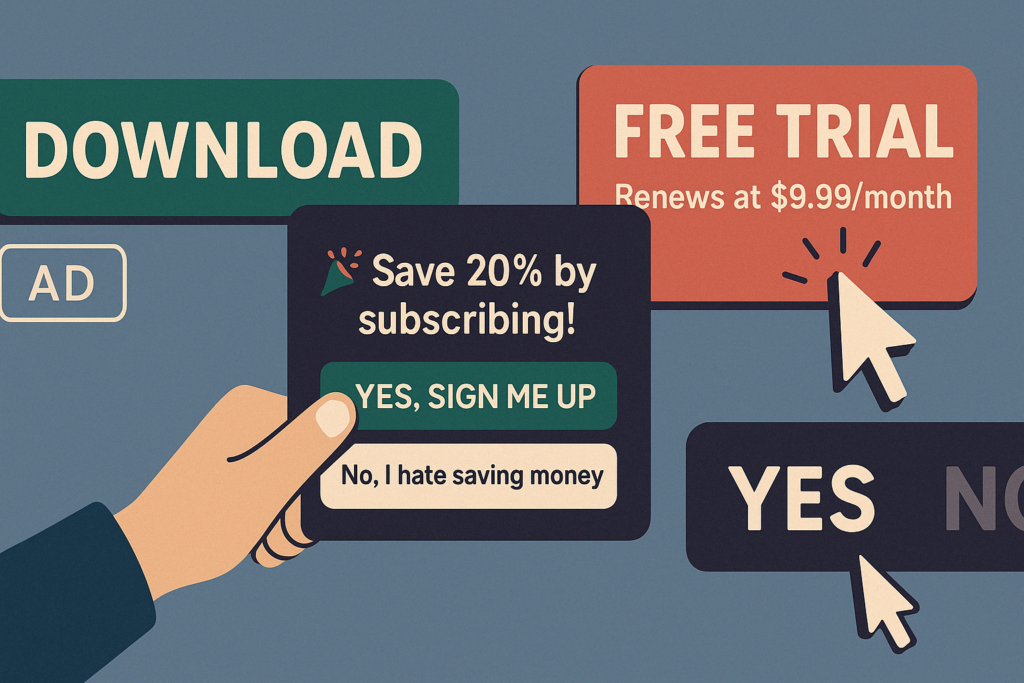
Dark Patterns Uncovered: A Critical Look at Deceptive Design Tactics
Let me begin by asking you this:
Is a quick business win ever worth losing users’ trust?
Before we even think about using dark patterns, this is the question we should sit with.
Most of us have come across them.
Some of us have been tricked by them, maybe without even knowing.
Often called deceptive patterns, dark patterns are design tricks that coerce or mislead users into actions they might not otherwise take.
They often boost short-term conversions for businesses, but at a steep cost to user trust and experience.
This is Part 1 of a two-part series exploring the world of dark patterns in UX.
Today, I’ll cover the definition, explore the psychology behind how they work, and break down the most common types of dark patterns in digital products today.
Part 2 (released next week) will dive into the ethics (or lack thereof) of deceptive design, global regulations pushing back against these patterns, and examples of ethical UX done right.
📌What’s Inside (Part 1)
- What are dark patterns, and where did they come from?
- Psychology behind how they work
- Common types of dark patterns in UX (with examples)
💬 So, once again:
Is any short-term business gain ever worth the long-term damage to user trust?
If you’re anything like me, the answer’s already clear – and it’s no.
As UX professionals, we’re constantly balancing business objectives with user needs.
We’re expected to drive engagement, support growth, and yes, sometimes boost monetisation.
But we also know that the most powerful driver of retention, loyalty, and advocacy is something far harder to quantify: trust.
And that’s where it gets messy.
We’ve all seen it…
Interfaces designed not to help the user, but to nudge, guilt, confuse or trap them.
Whether it’s sneaky subscriptions, consent buried under five layers of settings, or decline buttons that shame you for opting out, dark patterns are (sadly) becoming the norm.
And when they “work”, they really do…
for a moment.
But what happens after that moment?
What happens when the user realises they’ve been tricked, manipulated, or nudged into doing something they didn’t want?
They leave. And they don’t come back.
I know I don’t.
If I’ve been misled, subscribed without consent, or had my attention hijacked – that’s it. It feels intrusive and wrong.
Think about this: especially now, in a market oversaturated with manipulation and short-term thinking, there’s an opportunity to stand out by NOT following the crowd.
Not just because it’s ethical, but because it works.
Users reward transparency. They remember respect.
They return to products that value their autonomy.
Next week, in Part 2, we’ll explore why that approach isn’t just better for people, but it’s better for business too.
I know I don’t.
If I’ve been misled, subscribed without consent, or had my attention hijacked – that’s it. It feels intrusive and wrong.
Think about this: especially now, in a market oversaturated with manipulation
We’ll unpack the ethical implications, look at legal regulations, and see what ethical, trust-centred design can really look like.
But for now, let’s start with the basics:
What are dark patterns, how do they work, and how can we recognise them before they do more harm than good?
⏭️ Coming Next: Ethics, Regulation & Honest UX
In Part 2, we’ll look at what happens when deceptive design meets regulation, what ethical alternatives look like, and how transparent UX is becoming a competitive advantage.
We’ll also talk about your role as a UX professional.
Because the best way to stand out today is to design with honesty.
This space thrives because of YOU. ❤️
If the resources I share help you grow, a small contribution from you could keep this community strong.
Every bit helps, and by supporting me, you’re directly helping keep this space alive and growing.❤️⬇️
Or simply scan this QR code ⬇️

Your support means a lot!
You might also like:
📚 Sources & Further Reading
- Princeton University Study: Dark Patterns at Scale
- How to Use Dark Patterns – IONOS
- The Real Impact of Dark UX Patterns – by Alex Hill | UX Collective
- Deceptive Patterns in UX: How to Recognize and Avoid Them – Nielsen Norman Group
- Dark Patterns Designs That Pull Evil Tricks on Our Brains – Infinum
- FTC Sues TurboTax Maker Intuit Over “Free” Ads
- Amazon Forced to Simplify Prime Cancellation After EU Pressure
- Green Man Gaming Checkout Dark Pattern Example
- Deceptive Patterns
- Audible’s Hard-to-Cancel Subscription Tactics
Share this article:

Your blog is like a beacon of light in the vast expanse of the internet. Your thoughtful analysis and insightful commentary never fail to leave a lasting impression. Thank you for all that you do.
Hi Wiley, thanks so much for the lovely feedback. I’m really glad you’re finding my content useful! All the best 🙂